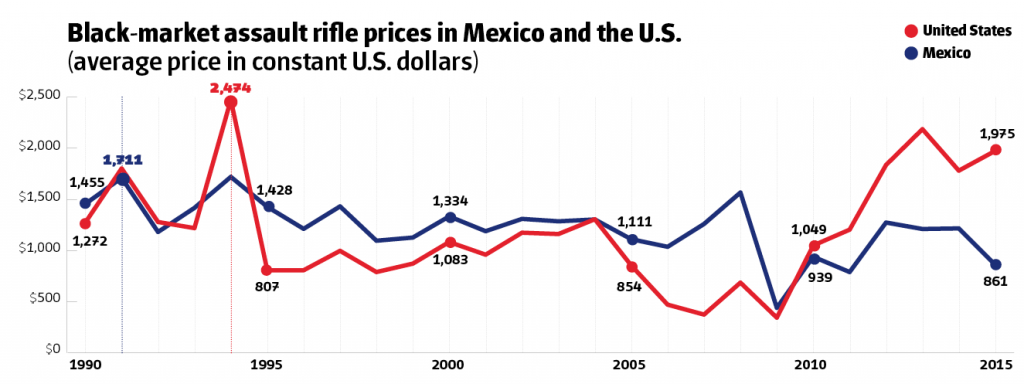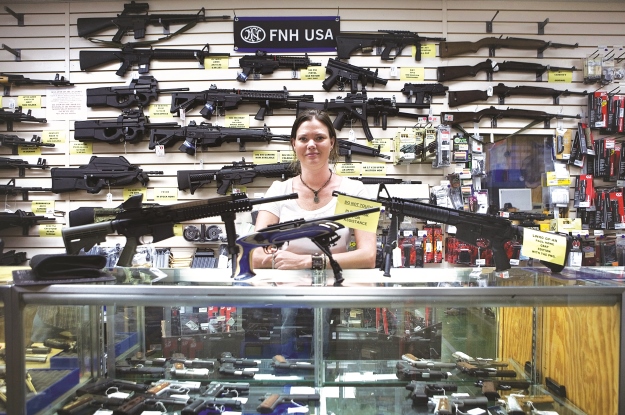This article is adapted from AQ’s 2017 special report on the U.S.-Mexico relationship. To receive AQ at home, subscribe here.
That Mexico’s drug cartels get their firepower from the United States is no longer much of a mystery. Even President Donald Trump has acknowledged that the U.S. should do more to curb the flow of arms across its southern border.
But Trump’s plan to stop that flow — at least as it pertains to the construction of a “great wall” — doesn’t fully take into account the market forces of the arms trade on both sides of the border. Any effort to limit Mexican cartels’ access to arms will first require policies that more closely monitor legal sales in the United States.
Over the eight years that President Barack Obama was in office, the price of firearms on the U.S. black market rose dramatically, due in part to lobbying by the U.S. gun industry that drove demand. The rise was so significant that by 2010 (and for the first time since the 1994 passage of the Assault Weapons Ban) the cost of black-market guns in the U.S. exceeded the cost of buying the same weapons on the black market in Mexico—where legal weapons are difficult to procure. Yet contrary to what basic economics would predict, hundreds of thousands of guns continued to flow from the U.S. to Mexico over that time.
The reason is that legal sales—made mostly through “straw man” purchasers who are able to buy guns in the U.S. openly—account for the majority of the weapons that land in cartel hands. In 2014, roughly 70 percent of all traceable illegal weapons recovered in Mexico were tracked back to licensed U.S. vendors. Approximately four of 10 of these weapons originated in Texas.

Part of the problem is that the southward flow of firearms from the U.S. to Mexico constitutes an economic boon for gun manufacturers and retailers, and there are considerable financial incentives to maintain the status quo. A few years ago, the Igarapé Institute estimated that 2.2 percent of all U.S. domestic firearms sales from 2010-2012 eventually made their way south of the border. That amounts to an astonishing 212,887 firearms every year, equivalent to $127 million in income for U.S. gun sellers.
If the U.S. truly wishes to turn off the gun-trafficking tap, as Trump has suggested, the administration must focus first on legal sales. The solutions are widely known: universal background checks, a comprehensive sales registry, and safeguards to limit straw purchasers. Even if broader consensus on gun policy in the U.S. is hard to achieve, improving oversight of outbound traffic at customs would go a long way toward limiting the flow of arms.
Granted, these measures are not without limitations. They are focused on constraining supply, and in theory supply-side efforts in the face of inelastic demand can lead to higher profit margins without reducing total volume (the U.S. approach to the war on drugs comes to mind).
But there is some merit to supply-side approaches to reducing U.S. weapons sales. First, guns are a unique product in that they create their own demand. The more guns there are in a society, the more they generate insecurity, and spur further demand. Thus, by making guns less available through tougher regulations on legal purchases and interdiction, demand can be reduced. Second, supply-side approaches to curbing firearms trafficking can have a radical effect on cartels by virtue of the parts of the supply chain they target. Domestic curbs on straw man purchases will, in effect, raise the price of firearms for cartels and cut into their profits.
These common-sense solutions may be a hard sell in a polarized political environment, but they are vitally important for Mexico. The country’s homicide rate is on the rise again after dropping from a peak of 23.5 per 100,000 people in 2011. Cities on the border have been hard hit. Tijuana, for example, experienced the most violent year in its history in 2016, with 910 registered homicides in a city of just 1.7 million people. The proportion of homicides involving firearms has also been steadily rising, from around 50 percent of all murders in the 1990s to 68 percent in 2011.
If Trump’s wall (and accompanying electronic monitoring capacity) could be linked with a U.S. domestic sales registry, any arms interdicted at the border could be traced back to a lawful U.S. buyer, who might then be prosecuted as a straw purchaser. Such integration could bolster domestic law enforcement efforts. But a physical barrier on its own would have a negligible impact on arms trafficking, both for the reasons above and because U.S.-Mexican smuggling occurs between the cracks of two overburdened U.S. bureaucracies. Immigration and Customs Enforcement is traditionally focused on interdicting illegal inflows—not outflows—of people, drugs and weapons. As a result, Mexican authorities consider the Bureau of Alcohol, Tobacco, Firearms and Explosives their lead counterpart, even though that agency is ostensibly only responsible for enforcing domestic laws.
Even assuming the unlikely case that wall-building along the border succeeds in catching more gun traffickers, what then? If Mexican cartels feel compelled to compete and defend themselves with weapons, demand will persist. As a result, profits will simply rise for those trafficking syndicates that are able—by whatever means—to deliver the goods.
The tricky question of U.S.-Mexico firearms trafficking needs to be comprehensively addressed. A retreat to alternative facts will not help save either American or Mexican lives. What is amply clear is that the U.S. should have a strong sense of self-interest to ensure stability in Mexico. And ensuring this security on the other side of the border will require designing and enforcing much more responsible firearms policies at home.
—
Muggah is cofounder and research director of Igarapé Institute, a leading think-and-do tank in Brazil.
McDougal is an associate professor at the Joan B. Kroc School of Peace Studies at the University of San Diego





